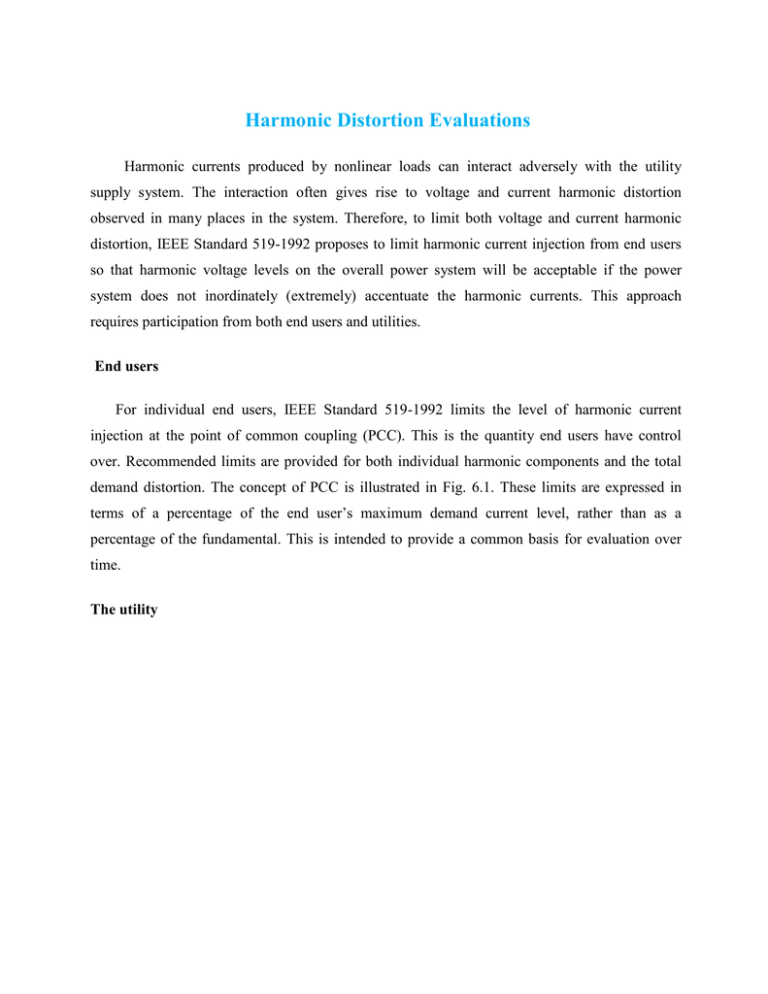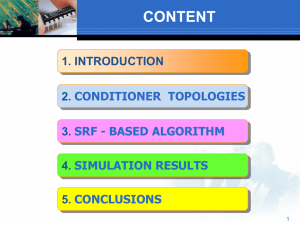Harmonic Distortion Evaluations
advertisement

Harmonic Distortion Evaluations Harmonic currents produced by nonlinear loads can interact adversely with the utility supply system. The interaction often gives rise to voltage and current harmonic distortion observed in many places in the system. Therefore, to limit both voltage and current harmonic distortion, IEEE Standard 519-1992 proposes to limit harmonic current injection from end users so that harmonic voltage levels on the overall power system will be acceptable if the power system does not inordinately (extremely) accentuate the harmonic currents. This approach requires participation from both end users and utilities. End users For individual end users, IEEE Standard 519-1992 limits the level of harmonic current injection at the point of common coupling (PCC). This is the quantity end users have control over. Recommended limits are provided for both individual harmonic components and the total demand distortion. The concept of PCC is illustrated in Fig. 6.1. These limits are expressed in terms of a percentage of the end user’s maximum demand current level, rather than as a percentage of the fundamental. This is intended to provide a common basis for evaluation over time. The utility Since the harmonic voltage distortion on the utility system arises from the interaction between distorted load currents and the utility system impedance, the utility is mainly responsible for limiting the voltage distortion at the PCC. The limits are given for the maximum individual harmonic components and for the total harmonic distortion (THD). These values are expressed as the percentage of the fundamental voltage. For systems below 69 kV, the THD should be less than 5 percent. Sometimes the utility system impedance at harmonic frequencies is determined by the resonance of power factor correction capacitor banks. This results in a very high impedance and high harmonic voltages. Therefore, compliance with IEEE Standard 5191992 often means that the utility must ensure that system resonances do not coincide with harmonic frequencies present in the load currents. Thus, in principle, end users and utilities share responsibility for limiting harmonic current injections and voltage distortion at the PCC. Since there are two parties involved in limiting harmonic distortions, the evaluation of harmonic distortion is divided into two parts measurements of the currents being injected by the load and calculations of the frequency response of the system impedance. Measurements should be taken continuously over a sufficient period of time so that time variations and statistical characteristics of the harmonic distortion can be accurately represented. Sporadic measurements should be avoided since they do not represent harmonic characteristics accurately given that harmonics are a continuous phenomenon. The minimum measurement period is usually 1 week since this provides a representative loading cycle for most industrial and commercial loads. Concept of point of common coupling Evaluations of harmonic distortion are usually performed at a point between the end user or customer and the utility system where another customer can be served. This point is known as the point of common coupling. The PCC can be located at either the primary side or the secondary side of the service transformer depending on whether or not multiple customers are supplied from the transformer. In other words, if multiple customers are served from the primary of the transformer, the PCC is then located at the primary. On the other hand, if multiple customers are served from the secondary of the transformer, the PCC is located at the secondary. Figure 6.1 illustrates these two possibilities. Figure 6.1 PCC selection depends on where multiple customers are served. (a) PCC at the transformer primary where multiple customers are served. (b) PCC at the transformer secondary where multiple customers are served. Note that when the primary of the transformer is the PCC, current measurements for verification can still be performed at the transformer secondary. The measurement results should be referred to the transformer high side by the turns ratio of the transformer, and the effect of transformer connection on the zero-sequence components must be taken into account. For instance, a delta-wye connected transformer will not allow zero-sequence current components to flow from the secondary to the primary system. These secondary components will be trapped in the primary delta winding. Therefore, zero-sequence components (which are balanced triplen harmonic components) measured on the secondary side would not be included in the evaluation for a PCC on the primary side. Harmonic evaluations on the utility system Harmonic evaluations on the utility system involve procedures to determine the acceptability of the voltage distortion for all customers. Should the voltage distortion exceed the recommended limits, corrective actions will be taken to reduce the distortion to a level within limits. IEEE Standard 519-1992 provides guidelines for acceptable levels of voltage distortion on the utility system. These are summarized in Table 6.1. Note that the recommended limits are specified for the maximum individual harmonic component and for the THD. Note that the definition of the total harmonic distortion in Table 6.1is slightly different than the conventional definition. The THD value in this table is expressed as a function of the nominal system rms voltage rather than of the fundamental frequency voltage magnitude at the time of the measurement. The definition used here allows the evaluation of the voltage distortion with respect to fixed limits rather than limits that fluctuate with the system voltage. A similar concept is applied for the current limits. There are two important components for limiting voltage distortion levels on the overall utility system Harmonic currents injected from individual end users on the system must be limited. These currents propagate toward the supply source through the system impedance, creating voltage distortion. Thus by limiting the amount of injected harmonic currents, the voltage distortion can be limited as well. This is indeed the basic method of controlling the overall distortion levels proposed by IEEE Standard 519-1992. The overall voltage distortion levels can be excessively high even if the harmonic current injections are within limits. This condition occurs primarily when one of the harmonic current frequencies is close to a system resonance frequency. This can result in unacceptable voltage distortion levels at some system locations. The highest voltage distortion will generally occur at a capacitor bank that participates in the resonance. This location can be remote from the point of injection. Source : http://nprcet.org/e%20content/Misc/eLearning/EEE/IV%20YEAR/EE1005%20-%20POWER%20QUALITY.pdf


